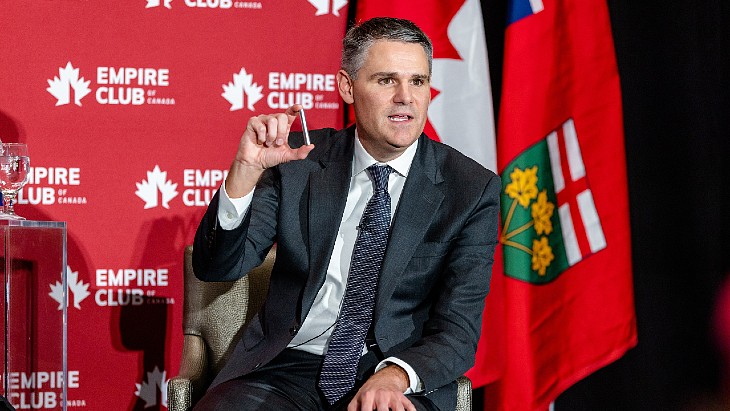Edison eyes SMR deployment in Italy
.jpg)
The company, which is celebrating its 140th anniversary, said it aims to double EBITDA to a range between EUR2.0-2.2 billion (USD2.1-2.3 billion) by 2030 from EUR1.1 billion in 2022. It said this goal will be achieved by a significant change in the industrial portfolio, which will result in direct zero or near-zero emission activities accounting for 70% of EBITDA, compared with an average of 35% over the past three years. Edison added that its 2030 business portfolio will see zero-emission electricity generation accounting for more than 45% of the group's profitability.
By 2040, Edison said it aims to have 90% of its generation mix decarbonised through the use of renewables and new technologies, such as CO2 capture and possibly new nuclear power. It anticipates reducing its CO2 emission factor from 293 grams per kilowatt-hour in 2022 to 190 g/kWh in 2030 and as low as 50 g/kWh in 2040, reducing absolute emissions in parallel.
"Looking ahead to 2040, Edison believes that nuclear energy will play a key role in achieving the EU's carbon neutrality targets, as a source capable of providing stability to the electricity system, offsetting the intermittency of renewables sources," the company said.
"Nuclear power is one of the generation sources with the lowest CO2 emissions, ensuring a low land footprint to installed capacity ratio, and allowing optimal programmability of production. Moreover, new SMR technology can be used to produce both electricity and heat, responding in a highly flexible way to the needs of energy-intensive districts and territories.
"Edison has the ambition to develop new nuclear power if the conditions are created for its return to Italy. In particular, Edison aims to build two nuclear power plants of 340 MW each with SMR technology between 2030 and 2040, leveraging on distinctive technological competencies of the shareholder EDF."
Edison CEO Nicola Monti added: "140 years ago we started the process of electrifying the country and ushered in a new era. Today, we are a leader in the energy transition and our history of leadership has accustomed us to responsibly looking to the future of the country through our contribution to the security, stability and autonomy of the national energy system for the benefit of all our customers.
"This means always looking ahead and making courageous choices today, bringing all stakeholders to a serious debate on how to integrate security and independence of supply with economic and environmental sustainability while maintaining a technological neutrality. Therefore, Edison continues to invest in innovation to create new Italian and European supply chains in the ecological transition, ensuring that the transition to the new era is an opportunity for progress for all."
In March, France's EDF - majority owner of Edison - signed a letter of intent with Italy's Ansaldo Energia, Ansaldo Nucleare and Edison to assess potential industrial cooperation for the development of nuclear power in Europe, including in Italy, specifically in the field of SMRs. At that time, the partners said they will assess the potential for the development and implementation of new nuclear power in Italy, "given the growing need for energy security and independence of the Italian electricity system".
EDF, through its Nuward subsidiary, is promoting the Nuward - a 340 MWe SMR plant with two pressurised water reactors (PWRs) of 170 MWe each. According to Nuward's SMR roadmap, the detailed design and formal application for a new nuclear facility is scheduled to begin in 2026, followed by first concrete in France in 2030 with the construction of that first unit anticipated to take about three years.
Italy operated a total of four nuclear power plants starting in the early 1960s but decided to phase out nuclear power in a referendum that followed the 1986 Chernobyl accident. It closed its last two operating plants, Caorso and Trino Vercellese, in 1990.
In late March 2011, following the Fukushima Daiichi accident, the Italian government approved a moratorium of at least one year on construction of nuclear power plants in the country, which had been looking to restart its long-abandoned nuclear programme. In a poll held in June of that year, 94% of voters rejected the construction of any new nuclear reactors in Italy. However, a poll conducted in June 2021 showed that one-third of Italians were in favour of reconsidering the use of nuclear energy in the country, with more than half of respondents saying they would not exclude the future use of new advanced nuclear technologies.
In May this year, the Italian Parliament approved a motion to urge the government to consider incorporating nuclear power into the country's energy mix. Last month, the first meeting was held of the National Platform for a Sustainable Nuclear, set up by the government to define a time frame for the possible resumption of nuclear energy in Italy and identify opportunities for the country's industrial chain already operating in the sector. It is planned to develop guidelines within nine months.
_92619.jpg)

_84504.jpg)







_88592.jpg)

